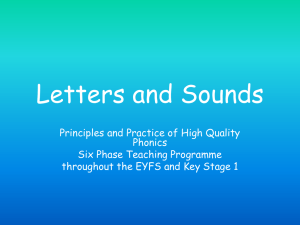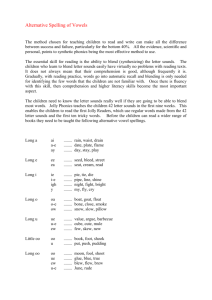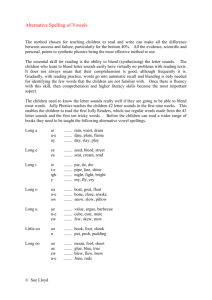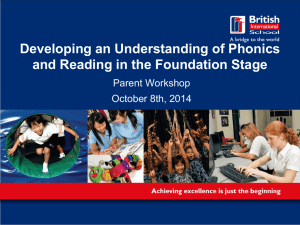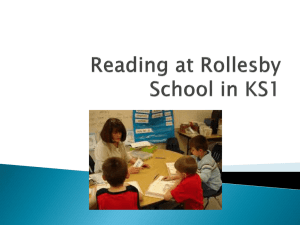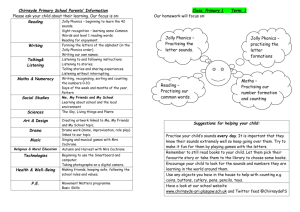Letters and Sounds: Phase Two
advertisement
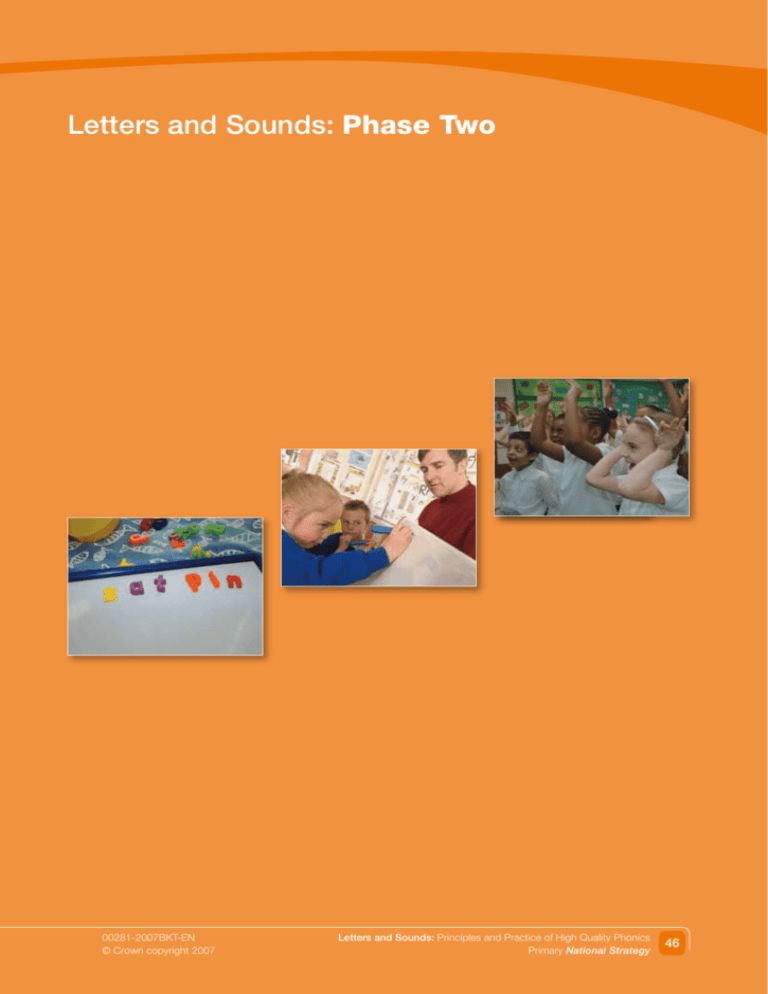
Letters and Sounds: Phase Two 00281-2007BKT-EN © Crown copyright 2007 Letters and Sounds: Principles and Practice of High Quality Phonics Primary National Strategy 46 Phase Two Letters and Sounds: Phase Two (up to 6 weeks) Contents Page ■ Summary 48 ■ Suggested daily teaching in Phase Two 49 ■ Suggested timetable for Phase Two – discrete teaching 50 ■ Teaching sets 1–5 letters 51 ■ Practising letter recognition (for reading) and recall (for spelling) 52 ■ Practising oral blending and segmentation 55 ■ Teaching and practising blending for reading VC and CVC words 58 ■ Teaching and practising segmenting VC and CVC words for spelling 61 ■ Teaching and practising high-frequency (common) words 64 ■ Introducing two-syllable words for reading 65 ■ Teaching reading and writing captions 66 ■ Assessment 68 ■ Bank of suggested words for practising reading and spelling 69 ■ Bank of suggested captions for practising reading 71 Key This icon indicates that the activity can be viewed on the DVD. 47 Letters and Sounds: Principles and Practice of High Quality Phonics Primary National Strategy 00281-2007BKT-EN © Crown copyright 2007 Summary Letters and Sounds: Phase Two Children entering Phase Two will have experienced a wealth of listening activities, including songs, stories and rhymes. They will be able to distinguish between speech sounds and many will be able to blend and segment words orally. Some will also be able to recognise spoken words that rhyme and will be able to provide a string of rhyming words, but inability to do this does not prevent moving on to Phase Two as these speaking and listening activities continue. (See Appendix 3: Assessment). The purpose of this phase is to teach at least 19 letters, and move children on from oral blending and segmentation to blending and segmenting with letters. By the end of the phase many children should be able to read some VC and CVC words and to spell them either using magnetic letters or by writing the letters on paper or on whiteboards. During the phase they will be introduced to reading two-syllable words and simple captions. They will also learn to read some high-frequency ‘tricky’ words: the, to, go, no. The teaching materials in this phase suggest an order for teaching letters and provide a selection of suitable words made up of the letters as they are learned. These words are for using in the activities – practising blending for reading and segmenting for spelling. This is not a list to be worked through slavishly, but to be selected from as needed for an activity. It must always be remembered that phonics is the step up to word recognition. Automatic reading of all words – decodable and tricky – is the ultimate goal. Letter progression (one set per week) Set 1: s a t p Set 2: i n m d Set 3: g o c k Set 4: ck e u r Set 5: h b f, ff l, ll ss Magnetic boards and letters Magnetic boards and letters are very effective in helping children to identify letter shapes and develop the skills of blending and segmenting. For example, teaching sequences can be demonstrated to an entire teaching group or class on a large magnetic board followed by children working in pairs with a small magnetic board to secure the learning objective. Working in pairs in this way significantly increases opportunities for children to discuss the task in hand and enlarge their understanding. Once children are adept at manipulating magnetic boards and letters they can use them to extend many activities suggested in Phase Two and beyond. 00281-2007BKT-EN © Crown copyright 2007 Letters and Sounds: Principles and Practice of High Quality Phonics Primary National Strategy 48 Suggested daily teaching in Phase Two Letters and Sounds: Phase Two Sequence of teaching in a discrete phonics session Introduction Objectives and criteria for success Revisit and review Teach Practise Apply Assess learning against criteria Revisit and review ■ Practise previously learned letters ■ Practise oral blending and segmentation Teach ■ Teach a new letter ■ Teach blending and/or segmentation with letters (weeks 2 and 3) ■ Teach one or two tricky words (week 3 onwards) Practise ■ Practise reading and/or spelling words with the new letter Apply ■ Read or write a caption (with the teacher) using one or more high-frequency words and words containing the new letter (week 3 onwards) 49 Letters and Sounds: Principles and Practice of High Quality Phonics Primary National Strategy 00281-2007BKT-EN © Crown copyright 2007 Week 1 – Teach set 1 letters – Practise the letter(s) and sound(s) learned so far – Briefly practise oral blending and segmentation Week 2 – – – – – – Teach set 2 letters Practise all previously learned letters and sounds Briefly practise oral blending and segmentation Teach blending with letters (blending for reading) Practise blending for reading Practise blending and reading the high-frequency words is, it, in, at Week 3 – – – – – – – Teach set 3 letters Practise previously learned letters and sounds Briefly practise oral blending and segmentation Practise blending with letters (reading words) Teach segmentation for spelling Teach blending and reading the high-frequency word and Demonstrate reading captions using words with sets 1 and 2 letters and and Week 4 – Teach ck, explain its use at the end of words and practise reading words ending in ck – Teach the three other set 4 letters – Practise previously learned letters and sounds – Briefly practise oral blending and segmentation – Practise blending to read words – Practise segmentation to spell words – Teach reading the tricky words to and the – Support children in reading captions using sets 1–4 letters and the, to and and – Demonstrate spelling captions using sets 1–4 letters and and Week 5 – – – – – – – Week 6 Letters and Sounds: Phase Two Suggested timetable for Phase Two – discrete teaching Teach set 5 letters and sounds Explain ff, ll and ss at the end of words Practise previously learned letters and sounds Practise blending to read words Practise segmentation to spell words Teach reading tricky words no, go, I Support children in reading captions using sets 1–5 letters and no, go, I, the, to – Demonstrate spelling captions using sets 1–5 letters and and, to and the – Revise all the letters and sounds taught so far – Continue to support children in reading words and captions 00281-2007BKT-EN © Crown copyright 2007 Letters and Sounds: Principles and Practice of High Quality Phonics Primary National Strategy 50 Teaching sets 1–5 letters Letters and Sounds: Phase Two Teaching a letter Three-part example session for teaching the letter s Purpose ■ To learn to say a discrete phoneme, recognise and write the letter that represents that phoneme Resources ■ Fabric snake ■ Card showing, on one side, a picture of a snake (mnemonic) in the shape of the letter s with the letter s superimposed in black on the snake; on the other side, the letter s ■ Small whiteboards, pens and wipes or paper and pencils Procedure Hear it and say it 1. Display the picture of a snake. 2. Make a hissing noise as you produce a snake from behind your back; show the children the sssssnake and make the snake into an s shape. 3. Weave your hand like a snake making an s shape, encouraging the children to do the same. 4. If any children in the room have names with the s sound in them, say their names, accentuating the sssss (e.g. Ssssarah, Chrisssssss, Ssssssandip). 5. Do the same with other words (e.g. ssssand, bussss) accepting suggestions from the children if they offer, but not asking for them. See it and say it 1. On the card with the picture of the snake, move your finger down the snake from its mouth, saying sssss and saying sssnake when you reach its tail. 2. Repeat a number of times, encouraging the children to join in. 3. Write s next to the snake and say ssssssssssss. 4. Ask the children to repeat ssssssssssss. 51 Letters and Sounds: Principles and Practice of High Quality Phonics Primary National Strategy 00281-2007BKT-EN © Crown copyright 2007 5. Point to the snake and say sssssnake and to the s and say ssssssssssss. Letters and Sounds: Phase Two 6. Repeat with the children joining in. 7. Put the card behind your back and explain that when you show the snake side of the card, the children should say snake and when you show the s side of the card, they should say s. Say it and write it 1. Move your finger slowly down the snake from its mouth, this time saying the letter formation patter: Round the snake’s head, slide down his back and round his tail. 2. Repeat a couple of times. 3. Repeat a couple more times with the children joining in the patter as they watch you. 4. Ask the children to put their ‘writing finger’ or ‘pencil’ in the air and follow you in making an s shape, also saying the patter. Repeat a couple of times. 5. Ask them to do the same again, either tracing s in front of them on the carpet or sitting in a line and tracing s on the back of the child in front. 6. Finally, the children write s on whiteboards or paper at tables. Practising letter recognition (for reading) and recall (for spelling) As soon as the first three letters (s, a, t) are learned, play games to give the children lots of practice in recognising and recalling the letters quickly. Fast recognition of letters is very important for reading, and recall for spelling. A toy could ‘help’ you by doing the pointing (recognition) or saying the sounds of the letters (recall). Recognition (for reading) Flashcards Purpose ■ To say as quickly as possible the correct sound when a letter is displayed 00281-2007BKT-EN © Crown copyright 2007 Letters and Sounds: Principles and Practice of High Quality Phonics Primary National Strategy 52 Resources ■ Set of A4 size cards with a letter on one side and its mnemonic on the other (e.g. Letters and Sounds: Phase Two the letter s on one side and a picture of a snake shaped like an s on the other) Procedure 1. Hold up the letter cards the children have learned, one at a time. 2. Ask the children, in chorus, to say the letter-sound (with the action if used). 3. If the children do not respond, turn the card over to show the mnemonic. 4. Sometimes you could ask the children to say the letter-sounds in a particular way (e.g. happy, sad, bossy or timid – mood sounds). 5. As the children become familiar with the letters, increase the speed of presentation so that the children learn to respond quickly. Interactive whiteboard variation Resources ■ Interactive whiteboard with large letters stacked up one behind the other Procedure 1. Reveal letters one by one by ‘pulling’ them across with your finger, gradually speeding up. Frieze Resources ■ Frieze of letters ■ Pointing stick/hand Procedure 1. Ask the children to tell you the sounds of the letters as you point to the letters at random. 2. As the children become familiar with the letters, increase the speed of presentation so that the children learn to respond quickly. 3. Sometimes ask a child to ‘be teacher’ as this gives children confidence and gives you the opportunity to watch and assess them as they respond. 53 Letters and Sounds: Principles and Practice of High Quality Phonics Primary National Strategy 00281-2007BKT-EN © Crown copyright 2007 Interactive whiteboard variation Letters and Sounds: Phase Two Resources ■ Interactive whiteboard Procedure 1. Display the letters the children have learned. 2. Either point to one letter at a time or remotely colour one letter at a time and ask the children to tell you each letter-sound. Recall (for spelling) Fans Purpose ■ To find the correct letter in response to a letter-sound being spoken Resources ■ Fans with letters from sets 1 and 2 (e.g. s, a, t, p, i, n), one per child or pair of children Procedure 1. Say a letter-sound and ask the children to find the letter on the fan and leave it at the top, sliding the other letters out of sight. 2. If all the children have fans ask them to check that they have the same answer as their partners. If the children are sharing, they ask their partners whether they agree. 3. Ask the children to hold up their fans for you to see. Variations ■ The children have two different fans each. ■ The children work in pairs with three different fans. 00281-2007BKT-EN © Crown copyright 2007 Letters and Sounds: Principles and Practice of High Quality Phonics Primary National Strategy 54 Quickwrite letters Letters and Sounds: Phase Two Resources ■ Small whiteboards, pens and wipes for each child or pair of children Procedure 1. Say a letter-sound (with the mnemonic and action if necessary) and ask the children to write it, saying the letter formation patter as they do so. 2. If the children are sharing a whiteboard both write, one after the other. Practising oral blending and segmentation These blending and segmentation skills were introduced in Phase One with a soft toy that ‘could only speak and understand sound-talk’. Blending and segmenting are the inverse of one another and need regular practice during Phase Two but blending and segmentation with letters should replace oral segmentation and blending as soon as possible. Practising oral blending Purpose ■ To give children oral experience of blending phonemes into words so that they are already familiar with the blending process when they start to read words made from the letter-sounds they are being taught From time to time during the day, say some words in ’sound-talk’. For example: ■ sound-talk a word in an instruction (e.g. Give yourselves a p-a-t on the back); ■ say some of the children’s names in sound-talk when sending them to an activity or out to play. Georgie’s gym Resources ■ Soft toy 55 Letters and Sounds: Principles and Practice of High Quality Phonics Primary National Strategy 00281-2007BKT-EN © Crown copyright 2007 Procedure Use the soft toy to give instructions, ‘Georgie says’, for example: Letters and Sounds: Phase Two 1. Stand u-p. 2. Put your hands on your kn-ee-s, on your f-ee-t. 3. Put your finger on your n-o-se. 4. Bend one arm round your b-a-ck. 5. Wiggle your… What’s missing? Resources ■ Set of any six CVC objects from the role-play area (e.g. hospital: soap, pen, chart, book, mug) ■ List of nine words for the teacher to read out, which includes the six objects and three additional items (e.g. bed, sheet, pill) ■ Soft toy (optional) Procedure 1. Pretext: you (or the soft toy) need to check that you have collected together all the items you need, which are written on your list. 2. Display the six objects. 3. Say one of the words on the list using sound-talk, ask the children to repeat it and then tell their partners what it is. 4. The children look at the items in front of them to see if the object is there. 00281-2007BKT-EN © Crown copyright 2007 Letters and Sounds: Principles and Practice of High Quality Phonics Primary National Strategy 56 Letters and Sounds: Phase Two Practising oral segmentation Purpose ■ To give children experience of breaking words up orally into their constituent phonemes so that they can use their knowledge of letter-sounds to spell words Resources ■ Soft toy ■ List of words, pictures or objects Procedure 1. Pretext: the toy is deciding what to put into his picnic basket and the children are asked to help him decide, but he only understands sound-talk. 2. Ask the children whether he will need an item (e.g. jam). 3. If the children think he will, ask them to say the word and then tell the toy in sound-talk: jam, j-a-m. The children may benefit from making some action with their hands or arms in time to the sound-talk. 4. Continue with a series of both suitable and unsuitable items (e.g. cheese, mud, cake, nuts, juice, coal, ham, rolls, soap, mugs, mouse). 57 Letters and Sounds: Principles and Practice of High Quality Phonics Primary National Strategy 00281-2007BKT-EN © Crown copyright 2007 Letters and Sounds: Phase Two Teaching and practising blending for reading VC and CVC words Blending for reading is a combination of letter recognition and oral blending (see Notes of Guidance for Practitioners and Teachers, pages 10–11, for an explanation). Some children need a lot of practice before they grasp CVC blending. Teaching blending for reading Sound buttons Resources ■ Words on cards or on magnetic or an interactive whiteboard with sound buttons as illustrated at •• Procedure This sequence of suggestions will require building over a few days. 1. Display a VC word (e.g. it, at) and point to or draw a sound button under each letter. 2. Sound-talk and then tell the children the word. 3. Repeat, but ask the children to tell their partners the word after you have sound-talked it. 4. Repeat 2 and 3 with a CVC word. 5. Repeat 4 with a couple more words. 6. Display another word, ask the children to sound-talk it with you and then say the word to their partners. 7. Repeat 6 with a couple more words. 8. Display another word and ask the children to sound-talk it in chorus, wait for you to repeat the sounds after them and then say the word to their partners. 9. Repeat 8 with more words. 10. Finally, display another word and ask the children to sound-talk the word in chorus and then, without your repeating the sounds, say the word to their partners. 11. Repeat 10 with more words. This procedure can be ‘wrapped up’ in a playful manner by using a toy or a game but the purpose of blending for reading should not be eclipsed as the prime motive for the children’s learning (see ‘Practising blending for reading’ on page 59). 00281-2007BKT-EN © Crown copyright 2007 Letters and Sounds: Principles and Practice of High Quality Phonics Primary National Strategy 58 Letters and Sounds: Phase Two Practising blending for reading What’s in the box? Resources ■ Set of word cards (e.g. words containing sets 1 and 2 letters – see ‘Bank of suggested words for practising reading and spelling’ on page 69) ■ Set of objects or pictures corresponding to the word cards, hidden in a box ■ Soft toy (optional) Procedure 1. Display a word card (e.g. map). 2. Go through the letter recognition and blending process appropriate to the children’s development (see ‘Teaching blending for reading’ on page 58). 3. Ask the toy or a child to find the object or picture in the box. Variation 1 (to additionally develop vocabulary) 1. Attach some pictures to the whiteboard using reusable sticky pads or magnets or display some objects. 2. Display a word card. 3. Go through the letter recognition and blending process appropriate to the children’s development. 4. Ask a child to place the word card next to the corresponding picture or object. Variation 2 (when the children are becoming confident blenders) 1. The children sit in two lines opposite one another. 2. Give the children in one line an object or picture and the children in the other line a word card. 3. The children with the word cards read their words and the children with objects or pictures sound-talk the name of their object or picture to the child sitting next to them. 4. Ask the children to hold up their words and objects or pictures so the children sitting in the line opposite can see them. 59 Letters and Sounds: Principles and Practice of High Quality Phonics Primary National Strategy 00281-2007BKT-EN © Crown copyright 2007 5. Ask the children with word cards to stand up and go across to the child in the line opposite who has the corresponding object or picture. Letters and Sounds: Phase Two 6. All the children check that they have the right match. Small group with adult The following activities can be played without an adult present but when they are completed the children seek out an adult to check their decisions. Matching words and pictures (Resources as above). Procedure 1. Lay out the word cards and picture cards on a table. 2. Ask the children to match the word cards to the pictures. Buried treasure Purpose ■ To motivate children to read the words and so gain valuable reading practice Resources ■ About eight cards, shaped and coloured like gold coins, with words and nonsense words on them made up from letters the children have been learning (e.g. mop, cat, man, mip, pon, mon), buried in the sand tray ■ Containers representing a treasure chest and a waste bin, or pictures of a treasure chest and a waste bin on large sheets of paper, placed flat on a table Procedure Ask the children to sort the coins into the treasure chest and the waste bin, putting the coins with proper words on them (e.g. man) in the treasure chest and those with meaningless words (e.g. mon) in the waste bin. When children have blended the sounds to read a word a number of times on different occasions, either overtly or under their breath, they will begin to read the word ‘automatically’ without needing to blend. 00281-2007BKT-EN © Crown copyright 2007 Letters and Sounds: Principles and Practice of High Quality Phonics Primary National Strategy 60 Letters and Sounds: Phase Two Teaching and practising segmenting VC and CVC words for spelling Teaching segmentation for spelling is a combination of oral segmentation and letter recall (see Notes of Guidance for Practitioners and Teachers, pages 10–11, for an explanation). Some children need a lot of practice before they grasp CVC segmentation. Teaching segmentation Phoneme frame Resources ■ Large two-phoneme or three-phoneme frame drawn on a magnetic or interactive whiteboard as illustrated ■ Selection of magnetic letters (e.g. sets 1 and 2 letters) displayed on a whiteboard ■ List of words (visible only to the teacher) ■ Small phoneme frames, each with a selection of magnetic letters, or six-letter fans, one per child or pair of children ■ Soft toy (optional) Procedure This sequence of suggestions will require building over a few days. Children should be able to spell VC words before moving on to spell CVC words. 1. Say a VC word (e.g. at) and then say it in sound-talk. 2. Say another VC word (e.g. it) and ask the children to tell their partners what it would be in sound-talk. 3. Demonstrate finding the letter i from the selection of magnetic letters and put it in the first square on phoneme frame and the letter t in the second square, sound-talk i-t and then say it. 4. Say another VC word (e.g. in) and ask the children to tell their partners what it would be in sound-talk. 5. Ask the children to tell you what to put in the first square in the phoneme frame and then in the second. 6. Ask the children to make the word on their own phoneme frames or fans. 61 Letters and Sounds: Principles and Practice of High Quality Phonics Primary National Strategy 00281-2007BKT-EN © Crown copyright 2007 Letters and Sounds: Phase Two 7. If all the children have frames or fans, ask them to check that they have the same answer as their partners. If the children are sharing, they ask their partners whether they agree. 8. Ask the children to hold up their frames or fans for you to see. 9. Repeat 4–8 with another VC word (e.g. an). 10. Repeat 1–8 with three-phoneme (CVC) words containing the selection of letters. See ‘Bank of suggested words for practising reading and spelling’ (on page 69). This procedure can also be ‘wrapped up’ in a playful manner by ‘helping a toy’ to write words. Practising segmentation Phoneme frame See ‘Teaching and practising VC and CVC words for spelling’ (on page 61). Quickwrite words Resources ■ Large three-phoneme frame drawn on a magnetic whiteboard ■ Display of letters required for words ■ List of CVC words (visible only to the teacher) ■ Hand-held phoneme frames on whiteboards, pens and wipes, one per child or pair of children Procedure 1. Say a CVC word and, holding up three fingers, sound-talk it, pointing to a finger at a time for each phoneme. 2. Ask the children to do the same and watch to check that they are correct. 3. Holding up the three fingers on one hand, write the letters of the word in the phoneme frame, demonstrating how to refer to the letter display to recall a letter. 4. Ask the children to write the word in their phoneme frames. 5. Say another word and ask the children to sound-talk it to their partners using their fingers. 00281-2007BKT-EN © Crown copyright 2007 Letters and Sounds: Principles and Practice of High Quality Phonics Primary National Strategy 62 6. Ask them to sound-talk it in chorus for you to write it. Letters and Sounds: Phase Two 7. Repeat 5 and 6 but leave the last letter of the word for the children to write on their own. 8. Ask them to sound-talk (with fingers) and write more words you say. Full circle Resources ■ List of words (sat, sit, sip, tip, tap, sap, sat), magnetic whiteboards and letters (s, a, t, p, i), one per pair of children ■ List of words (pin, pit, sit, sat, pat, pan, pin), magnetic whiteboards and letters (s, a, t, p, i, n), one per pair of children ■ List of words (pot, pod, pad, sad, mad, mat, pat, pot), magnetic whiteboards and letters (p, t, d, m, s, o, a), one per pair of children ■ List of words (cat, can, man, map, mop, cop, cap, cat), magnetic whiteboards and letters (c, t, n, m, p, a, o), one per pair of children ■ List of words (leg, peg, pet, pat, rat, ran, rag, lag, leg), magnetic whiteboards and letters (l, g, p, t, r, n, e, a), one per pair of children ■ List of words (run, bun, but, bit, hit, him, dim, din, sin, sun, run), magnetic whiteboards and letters (r, n, b, t, h, m, s, d, i, u), one per pair of children Procedure 1. Give pairs of children a magnetic whiteboard and the appropriate letters for one game of ‘Full circle’. 2. Say the first word (e.g. sat) and ask the children to make it with their letters. 3. Write sat on the whiteboard and explain that the children are going to keep changing letters to make lots of words and that when they make sat again, they may call out Full circle. 4. Leave sat written on the whiteboard throughout the activity. 5. Ask the children to sound-talk sat and then sit and then to change sat into sit on their magnetic whiteboards. 6. Ask them to sound-talk and blend the word to check that it is correct. 7. Repeat with each word in the list until the first word comes round again and then say Full circle with the children. 63 Letters and Sounds: Principles and Practice of High Quality Phonics Primary National Strategy 00281-2007BKT-EN © Crown copyright 2007 Letters and Sounds: Phase Two Teaching and practising high-frequency (common) words There are 100 common words that recur frequently in much of the written material young children read and that they need when they write. Most of these are decodable, by sounding and blending, assuming the grapheme–phoneme correspondences are known, but only 26 of the high-frequency words are decodable by the end of Phase Two. Reading a group of these words each day, by applying grapheme–phoneme knowledge as it is acquired, will help children recognise them quickly. However, in order to read simple captions it is necessary also to know some words that have unusual or untaught GPCs (‘tricky’ words) and these need to be learned (see Notes of Guidance for Practitioners and Teachers, page 15). Teaching ‘tricky’ high-frequency words the • to •• I • go no •• •• Resources ■ Caption containing the tricky word to be learned (see ‘Bank of suggested captions for practising reading’ on page 71) Procedure 1. Explain that there are some words that have one, or sometimes two, tricky letters. 2. Read the caption, pointing to each word, then point to the word to be learned and read it again. 3. Write the word on the whiteboard. 4. Sound-talk the word and repeat putting sound lines and buttons (as illustrated above) under each phoneme and blending them to read the word. 5. Discuss the tricky bit of the word where the letters do not correspond to the sounds the children know (e.g. in go, the last letter does not represent the same sound as the children know in dog). 6. Read the word a couple more times and refer to it regularly throughout the day so that by the end of the day the children can read the word straight away without sounding out. 00281-2007BKT-EN © Crown copyright 2007 Letters and Sounds: Principles and Practice of High Quality Phonics Primary National Strategy 64 Letters and Sounds: Phase Two Practising reading high-frequency words Children should be given lots of practice with sounding and blending the 26 decodable high-frequency words so that they will be able to read them ‘automatically’ as soon as possible. They also need practice with reading the five tricky words, paying attention to any known letter–sound correspondences. Resources ■ Between five and eight high-frequency words, including decodable and tricky words, written on individual cards Procedure 1. Display a word card. 2. Point to each letter in the word as the children sound-talk the letters (as far as is possible with tricky words) and read the word. 3. Say a sentence using the word, slightly emphasising the word. 4. Repeat 1–3 with each word card. 5. Display each word again, and repeat the procedure more quickly but without giving a sentence. 6. Repeat once more, asking the children to say the word without sounding it out. Give the children a caption incorporating the high-frequency words to read at home. Introducing two-syllable words for reading Resources ■ Short list of two-syllable words Procedure 1. Write a two-syllable word on the whiteboard making a slash between the two syllables (e.g. sun/set). 2. Sound-talk the first syllable and blend it: s-u-n sun. 3. Sound-talk the second syllable and blend it: s-e-t set. 4. Say both syllables: sunset. 5. Repeat and ask the children to join in. 6. Repeat with another word. 65 Letters and Sounds: Principles and Practice of High Quality Phonics Primary National Strategy 00281-2007BKT-EN © Crown copyright 2007 Letters and Sounds: Phase Two Teaching reading and writing captions Reading captions Matching Resources ■ Three pictures and a caption for one of the pictures Procedure 1. Display the caption. 2. Sound-talk and read the first word (e.g. p-a-t pat). 3. Ask the children to repeat after you or join in with you, depending on their progress. 4. After sound-talking (if necessary) and reading the second word, say both words (e.g. a, pat a). 5. Continue with the next word (e.g. d-o-g dog, pat a dog). 6. Display the pictures and ask the children which picture the caption belongs to. Note: As children get more practice with the high-frequency words, it should not be necessary to continue sound-talking them. Shared reading When reading a shared text to the children for the purpose of familiarising them with print conventions (direction, one-to-one word correspondence, etc.) locate occasional VC and CVC words comprising the letters the children have learned, sound-talk and blend them. 00281-2007BKT-EN © Crown copyright 2007 Letters and Sounds: Principles and Practice of High Quality Phonics Primary National Strategy 66 Letters and Sounds: Phase Two Writing captions Demonstration writing Resources ■ Picture of subjects that have VC and CVC names (e.g. a cat sitting in a hat) Procedure 1. Display and discuss the picture. 2. Ask the children to help you write a caption for the picture (e.g. a cat in a hat). 3. Ask them to say the caption all together a couple of times and then say it again to their partners. 4. Ask them to say it again all together two or three times. 5. Ask the children to tell you the first word. 6. Ask what letters are needed and write it. 7. Remind the children that a space is needed between words and put a mark where the next word will start. 8. Ask the children to say the caption again. 9. Ask for the next word and ask what letters are needed. 10. Repeat for each word. Shared writing When writing in front of the children, take the occasional opportunity to ask them to help you spell words by telling you which letters to write. Independent writing When the children are writing, for example in role-play areas, their letter awareness along with their ability to segment will allow them to make a good attempt at writing many of the words they wish to use. Even though some of their spellings may be inaccurate, the experience gives them further practice in segmentation and, even more importantly, gives them experience in composition and helps them see themselves as writers. 67 Letters and Sounds: Principles and Practice of High Quality Phonics Primary National Strategy 00281-2007BKT-EN © Crown copyright 2007 Assessment Letters and Sounds: Phase Two (See Notes of Guidance for Practitioners and Teachers, page 16.) By the end of Phase Two children should: ■ give the sound when shown any Phase Two letter, securing first the starter letters s, a, t, p, i, n; ■ find any Phase Two letter, from a display, when given the sound; ■ be able to orally blend and segment CVC words; ■ be able to blend and segment in order to read and spell (using magnetic letters) VC words such as if, am, on, up and ‘silly names’ such as ip, ug and ock; ■ be able to read the five tricky words the, to, I, no, go. Some children will not have fully grasped CVC blending and segmentation but may know all the Phase Two letters. CVC blending and segmentation continues throughout Phase Three so children can progress to the next stage even if they have not mastered CVC blending. Writing Children’s capacity to write letters will depend on their physical maturity and the teaching approach taken to letter formation. Some children will be able to write all the letters in pencil, correctly formed. Most children should be able to form the letters correctly in the air, in sand or using a paint brush and should be able to control a pencil sufficiently well to write letters such as l, t, i well and h, n and m reasonably well. 00281-2007BKT-EN © Crown copyright 2007 Letters and Sounds: Principles and Practice of High Quality Phonics Primary National Strategy 68 Letters and Sounds: Phase Two Bank of suggested words for practising reading and spelling The words in this section are made up from the letters taught for use in blending for reading and segmentation for spelling. These lists are not for working through slavishly but to be selected from as needed for an activity (words in italics are from the list of 100 highfrequency words). Words using set 1 GPC Words using sets 1 and 2 GPCs For ** see next page at (+i) (+n) (+m) (+d) sat it an am dad pat is** in man sad tap sit nip mam dim sap sat pan mat dip [a*, as**] pit pin map din tip tin Pam did pip tan Tim Sid sip nap Sam and Words using sets 1–3 GPCs Words using sets 1–4 GPCs (+g) (+o) (+c) (+k) (+ck) (+e) (+u) (+r) tag got can kid kick get up rim gag on cot kit sock pet mum rip gig not cop Kim sack ten run ram gap pot cap Ken dock net mug rat nag top cat pick pen cup rag sag dog cod sick peg sun rug gas pop pack met tuck rot pig God ticket men mud rocket dig Mog pocket neck sunset carrot Teach that ‘ck’ together stands for the same sound as ‘c’ and ‘k’ separately – ck never comes at the beginning of a word, but often comes at the end or near the end. *The indefinite article ‘a’ is normally pronounced as a schwa, but this is close enough to the /a/ sound to be manageable. 69 Letters and Sounds: Principles and Practice of High Quality Phonics Primary National Strategy 00281-2007BKT-EN © Crown copyright 2007 (+h) (+b) (+f and ff) (+l and ll) (+ss) had but of** lap ass him big if let less his** back off leg hiss hot bet fit lot mass hut bad fin lit mess hop bag fun bell boss hum bed fig fill fuss hit bud fog doll hiss hat beg puff tell pass (north) has ** bug huff sell kiss hack bun cuff Bill Tess hug bus fan Nell fusspot Ben fat dull bat Letters and Sounds: Phase Two Words using sets 1–5 letters laptop bit bucket beckon rabbit When the letters l, s and f double at the ends of some words and c is joined by k, it is a good idea to draw a line underneath both letters to show that they represent one phoneme (e.g. hill, pick) when providing words and captions for reading, and encourage children to do so in their writing. **The sounds represented by f in of, and by s in as, is, has and his should also not cause problems at this stage, especially as children will not learn the letters v and z until several weeks later. Note that /f/ is articulated in the same way as /v/, and /s/ as /z/, apart from the fact that /f/ and /s/ are unvoiced and /v/ and /z/ are voiced. 00281-2007BKT-EN © Crown copyright 2007 Letters and Sounds: Principles and Practice of High Quality Phonics Primary National Strategy 70 Letters and Sounds: Phase Two Bank of suggested captions for practising reading Captions with sets 1–4 words pat a dog dad and nan a cat in a hat a nap in a cot a sad man a kid in a cap a pin on a map a tin can pots and pans cats and dogs Captions with sets 1–4 words + to, the a red rug rats on a sack get to the top a pup in the mud socks on a mat run to the den a cap on a peg mugs and cups a run in the sun an egg in an egg cup Captions, instructions and signs with sets 1–5 words + to, the, no, go a hug and a kiss on top of the rock a bag of nuts to huff and puff go to the log hut a hot hob sit back to back a duck and a hen a cat on a bed to the top of the hill get off the bus no lid on the pan pack a pen in a bag a doll in a cot a cat and a big fat rat The captions are included to provide a bridge between the reading of single words and the reading of books. They enable children to use and apply their decoding skills on simple material fully compatible with the word-reading level they have reached. This helps them to gain confidence and begin to read simple books. 71 Letters and Sounds: Principles and Practice of High Quality Phonics Primary National Strategy 00281-2007BKT-EN © Crown copyright 2007


